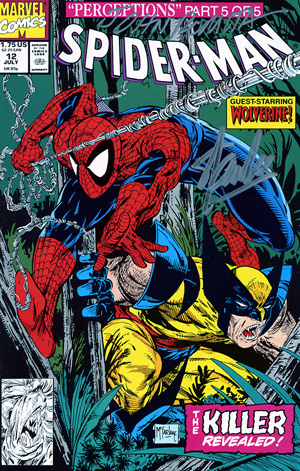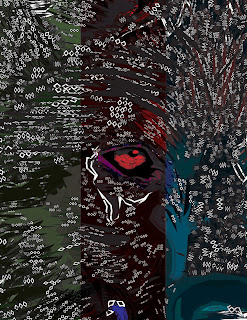BANKSY
Craft: For most of his work, Banksy seems to work mostly with a unique stencilling technique in his graffiti. For this bottom picture, in particular, it represents that very unique style of utilizing stencils. It seems this was done on a concrete wall of a building, perhaps an alley. The drawings are of a two Star Wars maned-walkers, the AT-ST (smaller), and the AT-AT (larger). The lettering "..I am your father" is a famous phrase referrencing the Star Wars saga. Banksy does not use much color at all, but rather focuses on very fine details in black in white. He has all the right shading and is very precise in the scaling of his art.
Composition: The stencil drawings seem to attract your eye first. Then you head toward the imporvised sections which consist of the quote and the question mark. He has both droids looking towards each other as if they are interacting as unmanned living organisms. It gives a sense of confrontation before you read the lettering, and afterwards a sense of paternal instinct.
Concept: It is obvious that this is meant to be a parody or Star Wars, if not, at the very least it is making fun of it. The bigger AT-AT is giving the impression of being a parental figure (the dad more specifically, after you read the statement). The smaller AT-ST strikes you as a small child. When the AT-AT says "I am your father," mimicking what Darth Vader says to Luke Skywalker, the AT-ST ponders the statement and is left in udder confusion as to how this is possible or implying, "Really? You're my father?"

STAN LEE

Craft: As a world-renowned classic comic book artist (and everything else he's done), Stan Lee has left his mark in history. The Marvel comic book of Spiderman and Wolverine edition depicted to the right can be seen to show a tremendous amount of color, detail, and style. It really focuses on shadows and exaggerates them, making them really dark. The yellow and red really grab your eye, while the blue hues complement each other. Darks and lights are are mixed and intermingled, yet still show a lot of organization and complementing when looking at how the colors are arranged. After being drawn in by the superheroes, you go to the title, then the subtitle, and finally all the sub headings. They are all in crazy fonts, but appropriate for the atmosphere.
Composition: The cover seems pretty hectic and chaotic with a lot of stuff in it even though it only has two characters. I appreciate all the chaos because it goes with the style of the comic. So much stuff wanting to be in the cover, that it suprisingly makes you want to open it and read what the heck is going on. You are interested in the idea of two superhereos crossing over and being in the same edition. Even if you didn't know who these two were, both of these characters seem pretty interesting and freaking cool with web going everywhere and Wolverine looking fierce. It seems that the different hues of green are so sublte and almost boring that they help bring out the hot-colored characters out more to the foreground.
Concept: This is obviously a comic made for entertainment featuring Spiderman with "gues-star," Wolvernine. It is a comic about action-packed superheroes who beat the bad guys and show that justice prevails.
When comparing Banksy with Stan Lee, it is quite a shift from one artist to another. Banksy is a mysterious and infemous graffiti artist more centered on the political side of things. On the other hand, Stan Lee is more of a fantasy guy, creating all of these crazy and amazing fictional characters. He relates to kids and even adults depicting what he knows we would all like to be. He does this in a way so as to also give the statement that all heroes are not superheroes. Sometimes it only takes an average person to do a courageous act of justice to become super and be good in society. Banksy is a little more devious and does not play by the law. In a way, he is more of an anarchist which seems to get him fame and adoration from his fans, while resentment and problems arise on the side with the law. His graffit has a distinct look to it. When you look at it, you automatically know: "Ah, that's Banksy." Similarly with Stan Lee, when you look at his comics, you know that the colorful action-packed superheroes on the cover are his signiture. Both are fasinating people who try to speak in the way they can- through art. They both try to send a message and hope that people hear and understand it.

